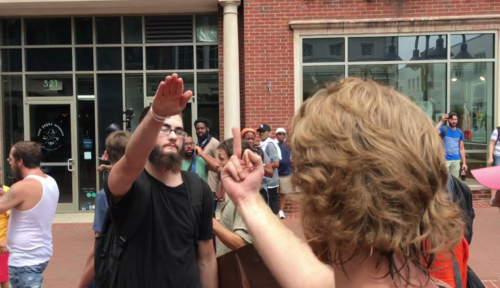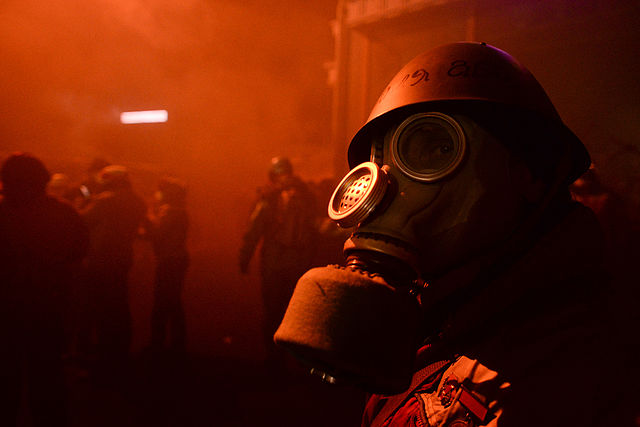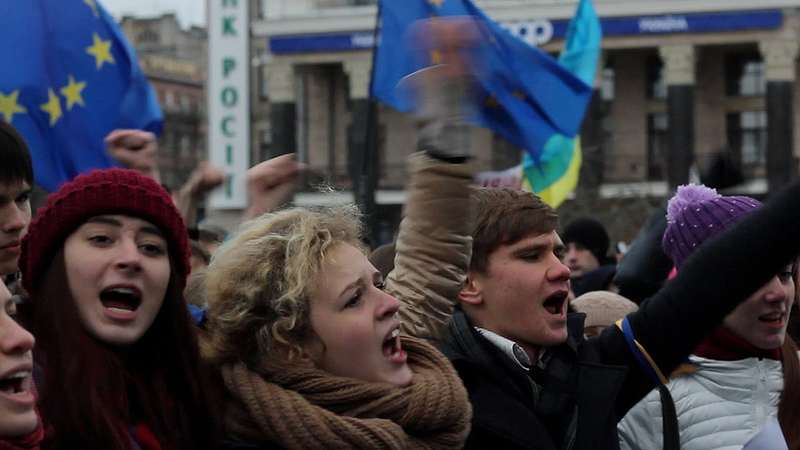Guest Post by Ioana Emy Matesan
President Trump sparked a public outcry when in the aftermath of the violence in Charlottesville he stated that both sides are to blame. When pushed and prodded, it became clear that POTUS believed that the “alt-right” movement was marching peacefully, before events escalated due to the behavior of “bad people” on both sides. President Trump is not the only one who holds these views. A CBS poll revealed that 68 percent of Republicans felt the President accurately assigned blame in this matter. In a Vice documentary that went viral, the white supremacist protesters were quick to point out they were marching nonviolently, displaying in fact incredible restraints. But what does nonviolence mean, when you carry torches, shout “blood and soil,” and have armed militia accompanying your marches? Underneath much of the scandal around the Charlottesville blame game lies a deeper issue: how do we define violence and nonviolence?
In the academia, much of the research on political violence and on terrorism is mainly focused on the behavioral engagement in violence. Yet, in the literature on radicalization and de-radicalization, scholars think of violence as a process that extends beyond behavior. For instance, many explicitly differentiate between psychological and physical disengagement from violence, in order to point out the difference between the renouncement of radical ideas, and the behavioral extrication from violent acts. On the other hand, in conflict resolution, disarmament is a key aspect of conflict de-escalation, underlining the importance of military capabilities for armed action (for more on DDR, go here, here and here). What this suggests, is that violence is about more than just behavior; it is also about ideas and capabilities.
To be sure, the link between ideas and behavior is highly contested, and we cannot assume a direct, linear pathway from radical ideas to violent behavior. Indeed, when applied to white supremacy groups, not all individuals with radical ideas are actively engaged in violent behavior against fellow citizens. Yet, it would be a mistake to consider them nonviolent activists. Instead, such individuals are engaged in rhetorical violence. The torches are a very vivid and explicit . “Blood and soil” invokes a very specific justification for behavioral violence and ethnic cleansing. The notion was originally a motto of German nationalism, which was later adopted as a foundational concept of national socialism by Walther Darré, who looked to farmers as the foundation of society and of the Nordic race, and believed that “Germany’s greatest challenge was that of maintaining racial purity.” Darré not only considered the Nordic race superior because of the “purity of the blood” and “its closeness to the soil,” but he also called on the Germans to “weed out the weak” and exterminate the impure.
Perhaps even more problematic than the rhetorical violence displayed in Charlottesville was the mobilization of armed militias. In countries such as Lebanon, Iraq or Yemen, such militias would be a tell-tale sign that the state has lost its monopoly over the legitimate use of . Of course, one may point out that this was just a display of military capabilities, and there was no physical engagement in armed action. Yet in my research, I find that having such military capabilities can lead to a slippery slope of militarization that ultimately does result in behavioral engagement in violence, and moreover in a gradual escalation of both the scope and the type of violence used.
Other cross-regional studies of armed groups also reveal that violence can have an emergent character and develop in action, heightening radicalism almost imperceptibly. Groups that have military capabilities also generally develop clandestinely, and the process of joining such a group in and of itself can lead to a gradual process of radicalization both in terms of ideas and behavior. This means that it is important to recognize that while the white supremacist protesters marching with guns were not actively engaged in armed attacks, they were passively violent, displaying the capability and intent to instill harm.
What does this mean in the post Charlottesville reality? First, we need to recognize that nonviolence is not simply the absence of physical violence. When we speak of nonviolent methods explicitly avoiding the threat or use of violence, we should also recognize the power of violent rhetoric, and the importance of violent capabilities. Second, if we are interested in protecting human life and reducing violence in society, then we need to expand our policy beyond fighting terrorism abroad, and focus on the many forms of violence that are present in our society. Third, we need to have a national conversation around these difficult cases when freedom of speech blends into hate speech, and the right of individuals to carry weapons turns into organized non-state actors possessing an armed wing. The ACLU is starting to rethink its position, announcing that it will no longer defend hate groups that protest with firearms. While this is a step towards the recognition that violence is multifaceted, dealing with the potential of violent escalation in the United States requires is a much broader conversation that should involve a variety of social actors, as well as academics and policy-makers.
Ioana Emy Matesan focuses on Middle East politics, particularly security and political violence, democratization and Islamist movements. In Egypt and Indonesia, Matesan conducted National Science Foundation-supported fieldwork exploring why groups adopt or abandon violence and how tactical and ideological change happens within Islamist movements. She has also researched and published on Hamas and the Israeli-Palestinian conflict, new security challenges in the Middle East and North Africa after the Arab Spring, and the dynamics of resistance to foreign rule. Her research has appeared in Studies in Conflict and Terrorism, Terrorism and Political Violence, Journal of Strategic Security, and Nations and Nationalism.








3 comments
Beautifully written, well argued, excellent conclusions. Well done, Emy
I wholeheartedly agree on all counts. But we also must look at preparedness for violence on the leftist (“antifa”) and anarchist sides.
I agree that encouragement to violence may, in a sense, be construed to be a form of violence. However, I believe that it is still speech. Speech deserves protection. When the law decides whether or not to protect an activity, it looks for bright lines. The difference between speech and non-speech is clear. It is certainly easier to discern the difference between speech and non-speech than it is to discern the difference between encouraging and not-encouraging violence.
An historical example: In the 1960s J Edgar Hoover considered Martin Luther King to be a communist, or a front for communists, dedicated to the violent overthrow of the US system. That’s a view that we would consider absurd today, but it was FBI policy then. That such a view can become policy illustrates how easy it is to blur the distinction between encouraging and discouraging violence. While Hoover could not say that King was violent, he could credibly theorize that King “encouraged” violence.
For the sake of preserving our free speech rights, I would protect the right-wing marchers, even with their guns and Nazi symbols, and I would urge the ACLU to defend them. E Williams